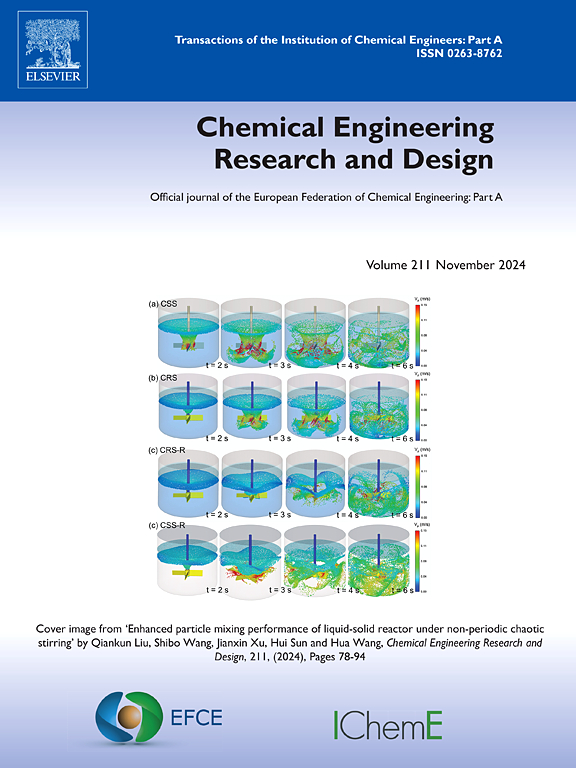Simulation and optimization of separation processes for the downstream of the catalytic oxidation of HCl as byproduct from the fluorochemical industry
IF 3.7
3区 工程技术
Q2 ENGINEERING, CHEMICAL
引用次数: 0
Abstract
The catalytic oxidation of gaseous HCl with a small amount of HF to Cl2 is of utmost importance and desire for chlorine recycling in the fluorochemical industry. Herein, based on the results from the catalytic oxidation of HCl as byproduct contaminated with HF and fluorocarbons from the production of 1,1,1,2-tetrafluoroethane (HFC-134a) over a recently developed RuO2/MgF2 catalyst, the separation and purification processes of the downstream from the catalytic oxidation unit were simulated and optimized using the Aspen Plus software. In the simulation and optimization, a separation flow for Cl2 purification was built up and the corresponding mass and energy balances were made as well. The results show that both produced H2O vapor and unconverted HCl from the catalytic reactor can be effectively removed by a two-stage cooling dehydration unit coupled with a three-stage drying tower to obtain 29.90 wt% hydrochloric acid. In addition, the relationship between the dehydration amount and the heat load of the drying tower was optimized, showing a H2SO4 (98.00 wt%) consumption of 11.8 kg per ton of Cl2 produced, i.e., 11.8 kg/t, in the drying tower. Furthermore, the gaseous mixture of Cl2 and O2 can be separated by a pressurized distillation unit, in which the operating pressure and temperature as well as the heat load of the condenser were optimized, showing that a liquified Cl2 concentration of 99.93 wt% with a recovery efficiency of 97.0 % can be achieved. The current research, therefore, provides some fundamental base for the industrialization of the recovery of Cl2 from the byproduct HCl in the fluorochemical industry.
模拟和优化氟化学工业副产品 HCl 催化氧化下游分离过程
在氟化学工业中,气态 HCl 与少量 HF 催化氧化成 Cl2 对氯的回收利用具有极其重要的意义和愿望。在此,根据在最近开发的 RuO2/MgF2 催化剂上催化氧化 1,1,1,2-四氟乙烷(HFC-134a)生产过程中副产品 HCl 与 HF 和碳氟化合物的结果,使用 Aspen Plus 软件模拟和优化了催化氧化装置下游的分离和净化过程。在模拟和优化过程中,建立了用于净化 Cl2 的分离流程,并进行了相应的质量和能量平衡。结果表明,催化反应器中产生的 H2O 蒸汽和未转化的 HCl 均可通过两级冷却脱水装置和三级干燥塔有效去除,从而获得 29.90 wt% 的盐酸。此外,还优化了脱水量与干燥塔热负荷之间的关系,结果表明,在干燥塔中,每生产一吨 Cl2,H2SO4(98.00 wt%)的消耗量为 11.8 千克,即 11.8 千克/吨。此外,Cl2 和 O2 的气态混合物可通过加压蒸馏装置进行分离,在该装置中,对操作压力和温度以及冷凝器的热负荷进行了优化,结果表明可实现液化 Cl2 浓度为 99.93 wt%,回收效率为 97.0%。因此,目前的研究为氟化学工业从副产品 HCl 中回收 Cl2 的工业化提供了一些基本依据。
本文章由计算机程序翻译,如有差异,请以英文原文为准。
求助全文
约1分钟内获得全文
求助全文
来源期刊

Chemical Engineering Research & Design
工程技术-工程:化工
CiteScore
6.10
自引率
7.70%
发文量
623
审稿时长
42 days
期刊介绍:
ChERD aims to be the principal international journal for publication of high quality, original papers in chemical engineering.
Papers showing how research results can be used in chemical engineering design, and accounts of experimental or theoretical research work bringing new perspectives to established principles, highlighting unsolved problems or indicating directions for future research, are particularly welcome. Contributions that deal with new developments in plant or processes and that can be given quantitative expression are encouraged. The journal is especially interested in papers that extend the boundaries of traditional chemical engineering.
 求助内容:
求助内容: 应助结果提醒方式:
应助结果提醒方式:


